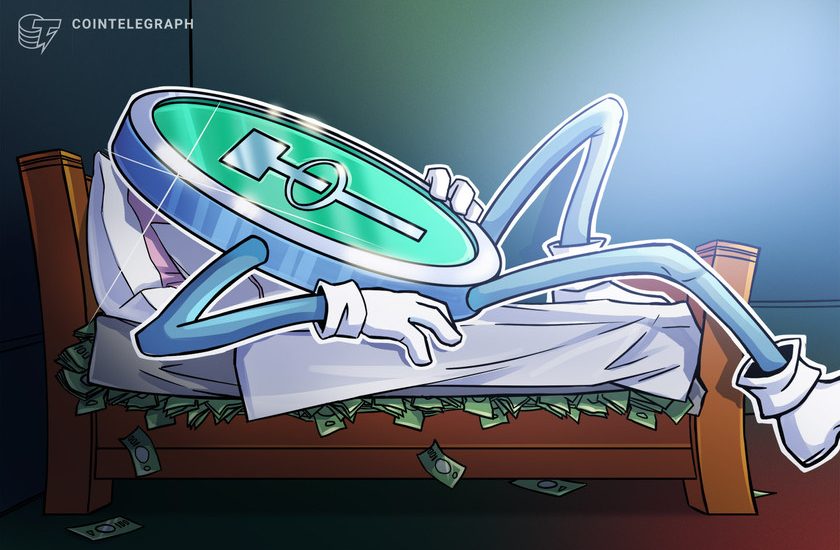- August 18, 2021
- Posted by: admin
- Category: BitCoin, Blockchain, Cryptocurrency, Investments


The market capitalization of the world’s largest stablecoin received a boost despite facing regulatory threats in the United States.
Tether Holdings Ltd, the issuer of the largest stablecoin, Tether (USDT), reported that its total market capitalization had crossed $64 billion for the first time in history.
The company called the event a “milestone,” adding that it is another indication of the cryptocurrency market’s “continued trust and confidence” in its stablecoin.
Tether’s $USDt market cap hits $64B!
A new milestone reached and another indication of the market’s continued trust and confidence in #Tether ! pic.twitter.com/t85i6e6UQt
— Tether (@Tether_to) August 16, 2021
In detail, Tether’s business model revolves around providing digitized dollars to cryptocurrency traders and investors. In doing so, the company offers them a way to park their volatile digital assets into USDT, a digital asset that maintains a one-to-one peg to the United States dollar.
As a result, Tether assists crypto traders and investors cut through the hassle of transferring their digital asset sale proceeds to a bank account.
The company’s business model has secured itself in the crypto industry, insomuch that trades between Bitcoin (BTC) and USDT are typically twice as frequent as trades between Bitcoin and the U.S. dollar.
Signaling crypto demand
Tether officials have earlier clarified that its fresh USDT issuances take place to meet orders from customers.
Therefore, a rising USDT market cap indicates that traders and investors may want to purchase the stablecoin and deploy it to purchase digital assets such as Bitcoin and Ether (ETH) and/or put them into yield farming contracts to earn annualized returns.
47,073,663 #USDT (47,073,663 USD) transferred from Compound Tether to unknown wallethttps://t.co/FC5ZjNLnRf
— Whale Alert (@whale_alert) August 18, 2021
A rising Tether issuance rate typically coincides with spikes in the Bitcoin market. For instance, the total market cap of USDT was around $4 billion in March 2020 but rose to over $61 billion in May 2021. The same period witnessed Bitcoin rising from below $4,000 to almost $65,000.

Moreover, Bitcoin’s correction from $65,000 to $30,000 coincided with a flat Tether market cap.
Later, BTC recovered on new endorsements from Tesla’s Elon Musk and Twitter’s Jack Dorsey and fears of higher inflation led by the U.S. Federal Reserve’s loose monetary policies.
Meanwhile, Glassnode data reports that 20% of Tether’s supply is currently locked in decentralized finance projects’ smart contracts.

“I foresee Tether continuing to virtually ‘print’ (mint) more and more Tether as the crypto industry continues to grow,” Gustavo De La Torre, business development director at N.exchange, said, hinting at a potential market boom that may follow in the sessions ahead.
“The growing supply indicates that the crypto ecosystem believes in its own system, carving out a means to peg trading pairs with an asset other than the US dollar.”
Commercial holdings
In June, JPMorgan Chase analysts noted that Tether’s large commercial paper holdings show that banks are unwilling to take the company’s cash. That could be due to the U.S. Office of the Comptroller of the Currency’s guideline that orders banks to work with only stablecoin issuers whose coins are 100% backed by reserves.

The banking giant added that providing Tether banking services would “likely raise reputational risk concerns” for financial institutions. However, Stuart Hoegner, general counsel at Tether, rubbished JPMorgan’s outlook, stating:
“With respect to reputation, we believe we are seeing the opposite: more and more counterparties are comfortable with Tether and our transparency initiatives and are keen to work with us.”
Regulation watch
Tether’s $64-billion “milestone” also appears as stablecoins, in general, attract more intense scrutiny from regulators.
The U.S. Treasury Department, the Securities and Exchange Commission and the Federal Reserve have expressed their concerns about the potential of dollar-pegged digital assets to cause global financial instability and obscure transactions associated with money launderers and other online criminals.
Related: SEC Chairman says cryptocurrency falls under security-based swaps rules
But to De La Torre, crypto traders have ignored regulatory threats over stablecoins’ feasibility as a product. He said:
“Should regulatory pressure heighten, other well regulated stablecoins like USDC may dominate American markets, however, Tether will still be relevant in other regions of the world.”
Bob Reid, CEO and co-founder of Everest, also highlighted Circle’s USD Coin attempt to mousetrap the U.S. market by attempting to get a national banking charter. The executive noted that Tether might follow a similar path to gain legitimacy in the U.S. or be ousted from the country altogether.
“Tether risks befalling in the same way as Binance, a shunned nomad with half the governments of the world hating them,” he told Cointelegraph.
The views and opinions expressed here are solely those of the author and do not necessarily reflect the views of Cointelegraph.com. Every investment and trading move involves risk, you should conduct your own research when making a decision.
